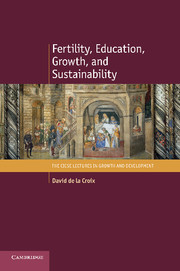Book contents
- Frontmatter
- Contents
- List of figures
- List of tables
- List of symbols
- List of definitions
- List of propositions
- Introduction
- PART ONE DIFFERENTIAL FERTILITY
- 1 Benchmark model
- 2 Implications for the growth–inequality relationship
- 3 Understanding the forerunners in fertility decline
- PART TWO EDUCATION POLICY
- PART THREE SUSTAINABILITY
- Bibliography
- Author index
2 - Implications for the growth–inequality relationship
from PART ONE - DIFFERENTIAL FERTILITY
Published online by Cambridge University Press: 05 December 2012
- Frontmatter
- Contents
- List of figures
- List of tables
- List of symbols
- List of definitions
- List of propositions
- Introduction
- PART ONE DIFFERENTIAL FERTILITY
- 1 Benchmark model
- 2 Implications for the growth–inequality relationship
- 3 Understanding the forerunners in fertility decline
- PART TWO EDUCATION POLICY
- PART THREE SUSTAINABILITY
- Bibliography
- Author index
Summary
The quantity–quality model was originally developed to account for fertility rates in the cross-section of a given country. In almost every country, fertility in the population at a given moment in time is a negative function of income. The quantity–quality model explains this observation in the same way that it accounts for the demographic transition. Since for educated women the opportunity cost of child-rearing time is high, they will prefer to invest in the education or “quality” of a small number of children. For less educated women, by contrast, the opportunity cost of raising children is low, while providing education is expensive relative to their income. Mothers with little education and low income would therefore prefer to have many children but invest little in the education of each child. Figure 2.1 illustrates this fact with detailed and robust data using twelve education categories for married mothers aged 45–70 in the US Census 1990. It shows that completed fertility drops monotonically with the education of the mother. Such a pattern for the USA was contested recently by Hazan and Zoabi (2011), who find a U-shaped relationship between period fertility and mother's education. However, even in their study, the fertility at the low end of the education distribution remains higher than the fertility of mothers with high education.
From recent research on developing economies we know that fertility differentials between high- and low-educated mothers can be quite large (Kremer and Chen (2002)).
- Type
- Chapter
- Information
- Fertility, Education, Growth, and Sustainability , pp. 20 - 47Publisher: Cambridge University PressPrint publication year: 2012

